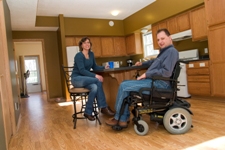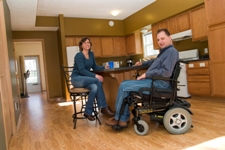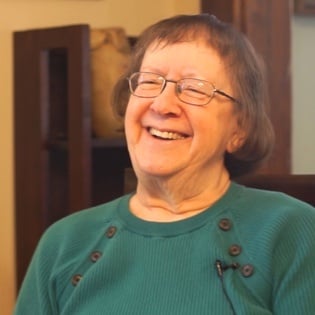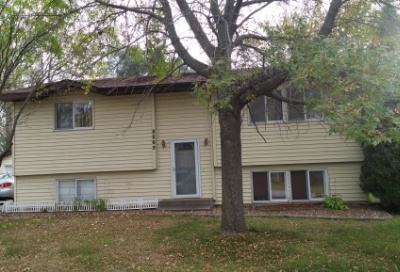Wheelchair accessible home is dream come true
Ron awoke to the smell of smoke but originally didn’t think much of it. Then came the fire alarm; there was Ron all alone with nowhere to go....

Ron awoke to the smell of smoke but originally didn’t think much of it. Then came the fire alarm; there was Ron all alone with nowhere to go. Relegated to a wheelchair and living on the third floor of his apartment building, there was no elevator to bring him to safety.
“I thought to myself there is no way I’m making it out of here on my own power,” said Ron. “Thankfully, the firemen were able to pound my door down. Then they wrapped me in sheets and carried me down the stairs.”

Scared of living alone after the fire, Ron, his girlfriend Tari, and her teenage daughter Tamme looked for apartments where they could live together. Finding an affordable place that was accessible for Ron’s wheelchair and large enough to accommodate their family of three was impossible. So they kept their separate apartments, hoping that one day they could afford a place for their family to call home.
One day while reading Access Press, Ron came across an article portraying the need for affordable housing for disabled people. Twin Cities Habitat for Humanity was holding informational meetings to get people with disabilities involved with the program. Ron and Tari braved a snowstorm, driving from Plymouth to attend a meeting in Minneapolis. That very night they began the application process and took their first steps towards owning their own home.
“It wasn’t more than a couple months after the meeting that we received the call telling us we had been selected for a home in Plymouth,” says Ron. “I was so thrilled to be a homeowner in the city I’ve lived in for the past 15 years.”
Twin Cities Habitat’s construction staff tailored a home for Ron’s special needs. Cupboards with shelves that slide out, lowered light switches, and specially positioned windows to help regulate Ron’s delicate body temperature, were a couple of the provisions made. Ron no longer deals with elevators or stairs and there are ramps leading to the front and back doors. As for Tari, she enjoys being able to come back with groceries for the week, walk a couple steps, and be inside her home.
When it came time for the family to put in their allotted sweat equity hours neither Ron nor Tari could participate as construction volunteers. Tari, recovering from major back surgery, spent her volunteer time doing data entry and mass mailings. Ron, on the other hand, put his photography talents to use by taking hundreds of snapshots of Habitat volunteers. Through the volunteer process both Ron and Tari developed lasting relationships with Habitat staff that they will never forget.
“Whether it was the site supervisors, AmeriCorps members or office staff,” Ron said. “It’s been an absolute joy getting to know everyone we have come in contact with through this program.”
Your gift unlocks bright futures! Donate now to create, preserve, and promote affordable homeownership in the Twin Cities.
Ron awoke to the smell of smoke but originally didn’t think much of it. Then came the fire alarm; there was Ron all alone with nowhere to go....

"I wish I could take my home with me,” Lilly said. Lilly was homebuyer number one for Twin Cities Habitat for Humanity back in 1986. She, and her...

Here at Habitat, our primary mission is to create and preserve affordable homeownership in the Twin Cities. Our passionate staff and volunteers...